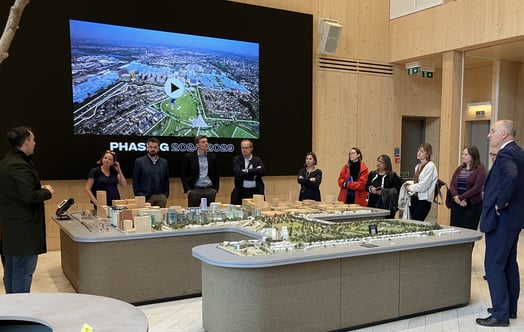Vattenfall’s Funding the Future event brought together principals from the Real Estate and Finance sectors with Government bodies and members of the Vattenfall Heat UK team to start a new, interdisciplinary dialogue.
It was, (ironically) a hot day on MS Teams in July when a group of leading industry figures met to discuss the innovation, leadership, levers and tools that can support the UK in its challenge to decarbonise heat. This was a timely discussion given the publication of the IPCC report shortly afterwards highlighting the massive investment required to limit global warming to the 1.5 degrees Paris target.
Vattenfall’s Funding the Future event, facilitated by Director of Commercial & Development Jenny Curtis, brought together principals from the Real Estate and Finance sectors with Government bodies and members of the Vattenfall Heat UK team to start a new, interdisciplinary dialogue. The aim is to identify the roles and contributions different players can make, in partnership, to tackle the estimated £29 billion cost of decarbonising domestic buildings by 2035.
Supporting research commissioned by Vattenfall from Frontier Economics set the scene in terms of the scale of the challenge. They presented various metrics to illustrate that whilst passing on costs direct to consumers through energy bills would be a regressive step, and although the size of the Energy Industry’s balance sheet is insufficient to absorb the full financial impact, the cost is somewhat dwarfed when compared to the total asset value of the property industry (and not to mention compared to the £372bn spent to date on Covid).
Participants were aligned in a desire for a stronger market framework and greater regulation to provide both carrot and stick to developers and consumers rather than a reliance on subsidy. This should be music to the ears of policy makers struggling to balance the books and working on the Heat and Buildings strategy, the future regulation of heat by Ofgem and proposals for heat zones.
It was acknowledged that subsidies may needed to bridge the affordability gaps between old and new technologies. This should only be while the supply chain for green heat develops and in time installation costs for heat pumps and other low carbon heating will fall and will move towards cost parity with gas.
The upskilling of the supply chain will be crucial. We cannot build back better or greener without the skilled resource to do so.
Currently the people that know most about heat pumps are air conditioning specialists. The government target of installing (not to mention maintaining) 600,000 heat pumps a year requires the retraining of fleets on boiler engineers.
Regulation also has a role in changing behaviour and strategy at the top level of real estate and finance companies. ESG is now front and central of any long term sustainable business. Requirements to disclose the carbon impact of business activities is one example of how the conversation has already moved from whether there is a ‘Green Premium’ to low carbon assets, to what the ‘Brown Discount’ is on a polluting portfolio and how to reduce embedded carbon in new developments.
The need for new financing structures to account for lower carbon technologies which have a different cash flow profile to traditional generation assets (e.g. higher upfront capex and longer paybacks but long asset lives) was noted. For example, ground rents could be used as a vehicle to secure long term annuity income to support on site energy infrastructure (to the extent such structures survive coming legislative changes). The ability to secure finance is of course linked to identifying the assets that create and maintain value – and how at a domestic level funding could be linked to the building not the consumer.
Whilst the lessons of the ill-fated Green Deal should not be forgotten, the principle of green mortgages takes forward this initiative and allows lenders to offer attractive rates to home owners and landlords that invest in improving the green credentials of their assets. Clear pricing and market signals are needed to accelerate these products. Labelling something green is not sufficient, and engaging with customers to secure behavioural change was acknowledged as pivotal to the transition.
Across property, finance, energy and government the narrative needs to be consistent and compelling to convince consumers of the long term economic benefits of green homes. If this element of value is to facilitate investment and drive value in the housing market, it needs to be made clear at each point of sale or rental, with customers having access to the right information and decision making tools at the time of distressed purchase; for example when replacing broken down gas boilers or undertaking major house refurbishment.
The Social rented sector was flagged as a potential party who could have a major role in driving this forward, given the size of their housing stock and the values of these landlords in both serving and protecting tenants whilst demonstrating real commitments to the green agenda.
A final thought was how we can learn lessons from other such major technological transitions. The decarbonisation of heat is in many ways more complex than the successful decarbonisation of the electricity industry (due to the customer interface and intrusive nature of retrofit), but the adoption of towns gas pioneered largescale change to domestic appliances, with other precedents including the phase out of analogue TV, and the nascent though promising looking move from fossil fuel to electric vehicles.
The aim of the event was not to come up with all the answers, but the diversity of thought and range of suggestions highlighted the underlying hypothesis that the energy, finance and property sectors will be stronger together in thinking through the often overlooked elephant in the room which is the decarbonisation of heat.
Nobody put their hand up to foot the bill, but we didn’t ask government for handouts and instead started to identify drivers of value and mitigations for cost.
Vattenfall would like to thank all attendees for their contributions, and we are keen to continue the debate and delve further in to both practical solutions and radical suggestions that can assist on unblocking net zero. Please do get in touch if you would like to pick up on any of the issues raised in this article.




